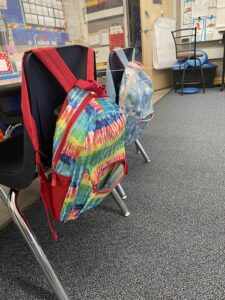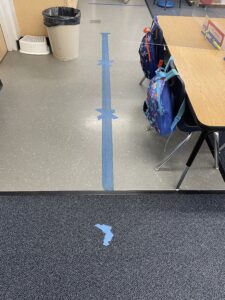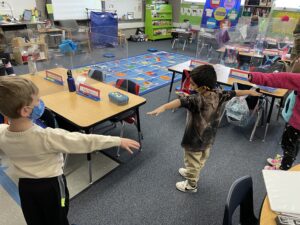Adaptations – Teaching in the 2020-2021 School Year, Part 2: ORGANIZATION
Welcome back! How are your adaptations coming along? Little by little, thing will improve, I promise! Let’s talk…ORGANIZATION.
This week’s blog is about organization in this 2020-2021 school year. Not so much the classroom set-up (although I do have a few more tips), which was my focus on the last blog, but ORGANIZATION in reference to planning, papers, and people.
PLANNING
I like to think of myself as an organized person. Unit planning is MY FAVORITE, and perhaps you know about my unit bins (see blog titled My Summer Dual Language To-Do List). However, as a teacher of both distance learners and in-person learners on a daily basis, I have had to up my organization skills tenfold.
Our year-long curriculum maps continue to play an important role in our planning, but each week is altered by so many interruptions: students unexpectedly excluded from in-person attendance because of the need to quarantine, smoke days (we had big fires at the beginning of the year that triggered unhealthy air quality), and snow delay starts and cancellations, to name a few. Our planning has had to be altered from the typical year-long plan. Click here to view a sample 50/50 map (not our map, but a great sample of what a non-pandemic biliteracy map looks like), and click here to view an 80/20 biliteracy map. What is very important for us, now, is our unit plan. We have broken down our units to focus on the more essential standards, and we know what is most important for our students to take away: ORACY. In order to be ready for literacy, they must have the oracy foundation first. So, what does that mean for planning purposes?
Each week we create a virtual classroom for each grade level, and in that virtual classroom we are sure to include the visuals and TPR our students who are at home will need to be able to participate fully, since they do not have the posters and visuals shared by the in-person learners. Here is an example of one of my recent virtual classrooms. (Be aware that some of the links will not work for you if you are not part of our district, but explore others as you like!)
We can’t rush building oracy. Believe me, I’ve tried it and it backfires badly. Too many times have I tried to introduce a read aloud full of rich language and engaging topics too soon in a unit, only to have my students sit with blank faces as the vocabulary, content, and/or themes went over their heads. Once I teach that oracy (through our TPR, Adapted Reader’s Theater, and other strategies that can be found in the Teaching for Biliteracy text, chapter 6), they engage fully and thoughtfully, and I can extract so much learning out of one text that it fills my lesson plans for days.
The best advice I can give you for these shortened days is to make sure your students have strong oracy skills. Build that listening and speaking, and we can then take steps toward applying it to reading and writing.
In addition to oracy building, we have attempted to pare down our units to focus on essential standards. When I began this process, I thought, Essential standards? Aren’t all the standards essential? That’s why we have them!
My answer now: Yes, AND… we need to think about which standards our students must know to a level of mastery in order to be prepared for the standards at the next grade level. All the standards are still important to teach, but we need to figure out which ones we need to spend the most time on. This wasn’t about eliminating the teaching of some standards, but rather determining which standards would received more time. This means spending time looking at the next grade level’s standards. This will drive where we spend most of our time in this shorter-than-normal school year.
Larry Ainsworth says it this way in his text Prioritizing the Common Core:
- Priority Standards are “a carefully selected subset of the total list of the grade-specific and course-specific standards within each content area that students must know and be able to do by the end of each school year in order to be prepared for the standards at the next grade level or course. Priority standards represent the assured student competencies that each teacher needs to help every student learn, and demonstrate proficiency in, by the end of the current grade or course” (Ainsworth, 2013, p. xv).
- Supporting Standards are “those standards that support, connect to, or enhance the Priority Standards. They are taught within the context of the Priority Standards, but do not receive the same degree of instruction and assessment emphasis as do the Priority Standards. The supporting standards often become the instructional scaffolds to help students understand and attain the more rigorous and comprehensive Priority Standards” (Ainsworth, 2013, p. xv).
- https://www.larryainsworth.com/prioritizing-the-common-core-power-standards/
Therefore, we’re prioritizing. I’ve had to cut out a few learning experiences that we didn’t have time for in our unit that spent more time on supporting standards than needed.
PAPERS
Ugh. Papers. They never end!! However, with a few procedures in place, you CAN get a handle on all.those.papers.
We make sure to have the schedule ready, the copies made, and the materials distributed for the following week by the same time each week. We began a routine to have our distance learning families to stop by the front office of the school between 2:15 and 4:00 on Fridays (or before school Mondays) to pick up materials for the upcoming week. Families know it will be there in a folder with their child’s name on it, and they can also then drop off any completed work from the current week. Our Friday afternoon Zoom sessions always leave an opening for families to have flexibility to come down to school to grab materials during that time. It is important to us that our learners at home have the same learning opportunities as the rest of the students, so we always include materials for the art projects and science/social studies inquiries we have planned as well as the guided reading books they will need.
We always send our virtual classrooms before 8:30am on Monday of each week, but we try to send them sooner. We also know that we are imperfect and that changes in the schedule occur, often last-minute. Because of that, we ask that distance learning families check their emails between 8:30 & 9:00 each day just in case something for that day needs to be changed or if we noticed we forgot something for their packets and it needs to be printed or found around the house. Families have been extremely understanding and helpful with making sure their children are set up and ready for a successful day/week of learning.
Our organization has also helped when a child is suddenly put on temporary distance learning. This might happen because a family member has tested positive for COVID, so the child must be quarantined for a time. We quickly zip an email to the family including the virtual classroom and schedule for the week. In just a few moments, we pull together the copies the child will need for that week because we got it all set up last week!
Also, because we don’t have desks, we purchased a “chair backpack” for each child this year. It hangs on the back of their chair and includes all their materials such as a mini whiteboard, their math books, their journals, a folder for English and a folder for Spanish, etc. If they are triggered to distance learning, we simply put their needed materials in the respective language folder, zip up the backpack, and bring it to the front of the school for the family to pick up. (Our school has a designated spot near the parking lot for families to pick up materials so that they do not have to enter the building.) When at home, the families know that this backpack has all the school materials, and when it is time to return back to school once again, it is easy to zip up and return the items back to class.
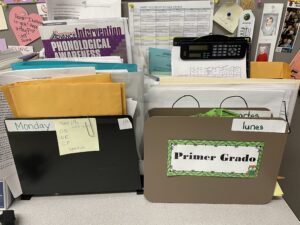
Here are the dividers for each day of the week. My materials for first grade are on the left, my teaching partner’s are on the right. We are getting used to sharing the same space!
The protocols for managing the paperwork and materials for our distance learners have also streamlined our organization for in-person learners. In each classroom we have weekly dividers, one for English and one for Spanish, with the copies, masters, and visuals we will need for the week. This may be an obvious one, but for us we had to think about it. Remember that before we had one classroom for English and one classroom for Spanish, so each of us had our materials in one room. Now that there is one room for First Grade and one room for Kindergarten, there is a lot of passing through and shared space, but it makes much more sense to store the materials we will need in the room where we’ll be using it!
PEOPLE
Oh, the people. They are why we are there! It feels so amazingly good to have students in front of us, and they absolutely love being at school. Most of our distance learners have adjusted to learning on the computer. Their families know that it is not ideal but are doing what’s best for their individual situations. Organizing our people has always been an important part of teaching. This year we must organize them on multiple platforms.
I include the distance learners in everything we are doing to the best extent that I can. They are called on just as often as the other students (in fact, sometimes a little more often so make sure that they are remaining engaged). They are thinking partners with each other (hint for teachers: put yourself on mute while virtual students are sharing, so that they don’t have the background noise of the classroom when they are talking!), and sometimes they play math games with in-person learners. They join us for guided reading groups (that’s a new teaching challenge!) and point their iPad at the book so I can monitor 1:1 correspondence and accuracy. When other students are speaking, I either bring the students close to the computer or I repeat the students’ comments, both to increase the ability of the distance learners to hear what is being said. All of these pieces are essential in helping our distance learners feel a part of our class community.
I mentioned in the first blog of this ADAPTATION series how we organize our thinking partners and table partners so that they can still work together. Interacting is so essential to learning language! We also have spots marked to line up for the sink (just like they have at the grocery store to keep us grown-ups separate!), colorful stickers to space out cubby access, and plexiglass partitions at our kidney table for small group work. In our classroom jobs this year, we even have a Distance Detective and Handwash Counter (see Principal Gerry’s ideas for a laugh!).
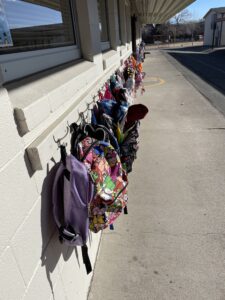
We have outdoor hallways, so students leave their backpacks on these hooks we had newly installed this year. They bring in only the materials they need for the day.
We had hooks installed outside our classrooms so that kids keep their “take-home” backpacks outside (as opposed to the “chair backpacks” referenced above) and only bring in the essentials. This also allows them space to come in each morning and take care of their personal needs. We open the classroom door 5 minutes earlier than in the past to allow the early birds to put their backpacks away, access their cubbies, and wash hands before the day begins. I get to greet them individually and although they cannot see my smile, they can hear the joy in my voice.
When we walk from place to place in the halls, we look like crooked airplanes! My
line of students has extended farther than it ever has, but my little airplanes keep a safe distance from each other with their
wings spread while we walk.
The most important thing I can say about organizing our people is to remind everyone that these little (or maybe big, depending on the grade you teach!) people are why we are teachers. At the beginning of the school year, I was afraid. I know that five-year-old fingers are often up noses, that sneezes sneak out of them often without warning, that handwashing isn’t always the top of their priority list, and that close talking is how all talking is done. I was sure that every single one of them would be walking COVID-transmitters. However, after two full quarters of school, not a single one of my 40 students has contracted coronavirus (thank goodness!). For the most part, parents have done an amazing job at self-screening their families before school each day and following the exclusionary protocols when a student or family member comes down with symptoms. Our cleaning measures have kept germs at bay, and we are healthy and learning.
I wish the same for you and your students. Please feel free to comment with questions, and join me for my next blog as I address how we have adapted our TECHNOLOGY and TEACHING FLEXIBILITY.



